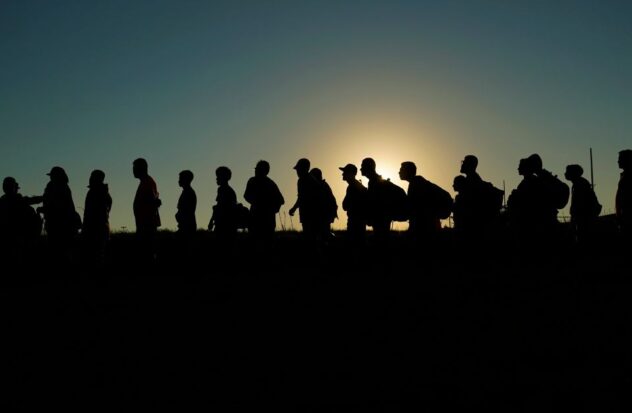TEXAS.- Behind huge metal fences reinforced with barbed wire, men dressed in blue play volleyball and basketball. Are migrants first-timers waiting for asylum or deportation in a Texas detention center.
Former naval base, the Port Isabel detention center, in the American city of Los Fresnos, is a few kilometers from the border line with Mexico and serves as a processing location for migrants who have crossed irregularly.
Coming from Latin America, Africa and Asia, thousands cross daily from Mexico to the United States in search of refuge and employment. After surrendering to border guards, families are usually quickly released, under the promise of appearing before an immigration judge.
But solo travelers often end up in a center like this.
“These detainees represent a risk to national security, to public safety, they are trying to evade border control efforts or crossed illegally,” explained Miguel Vergara, director of the local office of Enforcement and Deportation Operations, during a press visit to the facilities.
This detention center receives men. Upon arrival, they are sent to community cells with thick metal doors and cream walls. They can be observed through glass.
They remain there for a maximum of 12 hours before being classified: blue uniform for the first-timer, orange for those who have some type of history and red for those who represent danger.
Recently, President Joe Biden, seeking to address a complex issue five months into his presidential race with Donald Trump, announced a rule to stop the flow of migrants.
They will close the border to asylum seekers once 2,500 people have been processed in one day. It also facilitates deportations, a demand from the American right, which accuses it of allowing criminals to enter the country.
But this center remains close to its maximum capacity. This Monday they were guarding 1,006 migrants, out of a total of 1,175 spaces.
“The number remains stable depending on the town where we are,” Vergara explained.
“The migration is moving west, so it may have slowed down a little bit, but it’s just a matter of time” before facilities elsewhere fill up for referrals here, he explained.
Many languages
On the walls of the cells, which can hold up to twenty people, information is read in 15 languages.
After receiving their uniforms, they go through the center’s clinical area. On Monday morning, a young man from Ecuador and another from Guatemala were recovering in one of the rooms.
After screening, they are sent to wards according to their uniform color. The clothes they arrive in are washed and stored to be returned on the day of their release.
There are also ATMs where the migrant deposits their money – or receives it from their family member – to use it in a vending machine.
Liven up the wait
It’s just under noon at this center in Los Fresnos, hidden in the immensity of the Rio Grande Valley. There are signs in the surrounding area prohibiting hitchhiking. The heat hits.
Surveillance rooms using cameras and screens can be observed in various locations throughout the center.
The detainee’s stay should not exceed 90 days but sometimes it lasts for months, because some cases go to appeal.
The officials recognize that confinement can be desperate, and they offer activities such as music, singing or guitar, with classes sometimes taught by a volunteer migrant. Others learn English.
One group cuts the hair of their peers. They organize movie nights and once got a movie in Chinese for when they have had a large number of migrants from that country.
These days the largest number are represented by Ecuadorians.
Detainees have hours of outdoor recreation that vary depending on the weather.
There are those who dedicate themselves to making murals. A migrant painted the Liberty Bell, an icon of American independence, on a wall in the library.
Waiting answer
The migrant has private cubicles for a video call with an immigration officer, where he presents his asylum request.
The answer comes in writing. If it is negative, the migrant can appeal to an immigration judge, who has a court inside the detention center. The case can go all the way to the Supreme Court.
Whoever receives a definitive no is deported and whoever receives asylum must be released within a maximum of 48 hours. Those who wish to end the process can request return to their country, officials explain.
Meanwhile, a group of migrants dressed in blue review their cases in the library or read books. One of them is leafing through a Bible.
Source: With information from AFP






